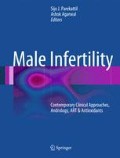Abstract
Spermatogenesis depends on an intricate interplay of hormonal factors both centrally and in the testis. Centrally, the hypothalamus releases gonadotropin-releasing hormone (GnRH), which acts on the anterior pituitary to cause secretion of luteinizing hormone (LH) and follicle-stimulating hormone (FSH). At the level of the testis, FSH acts on Sertoli cells to induce the maturation process in spermatogonia. LH exerts its effect on Leydig cells, stimulating production of testosterone. Effective spermatogenesis requires local testosterone concentrations to be much higher than serum concentrations. This intratesticular testosterone then acts indirectly to stimulate germ cell maturation through actions on Sertoli cells. Although endocrinopathies only account for a small minority of cases of male infertility, about 1–2%, the treatment of these conditions offers patients a strategy of directed therapy. Broad classification of endocrinopathies involves two main categories: hormonal deficiency and hormonal excess, with specific hormonal abnormalities falling under each of the above categorizations.
Access this chapter
Tax calculation will be finalised at checkout
Purchases are for personal use only
References
Alukal J, Lamb D, Niederberger C, Makhlouf A. Spermatogenesis in the adult. In: Lipshultz L, Howards S, Niederberger C, editors. Infertility in the male. New York: Cambridge University; 2009. p. 74–89.
Caroppo E. Male hypothalamic-pituitary-gonadal axis. In: Lipshultz L, Howards S, Niederberger C, editors. Infertility in the male. New York: Cambridge University; 2009. p. 14–28.
Kim HH, Schlegel PN. Endocrine manipulation in male infertility. Urol Clin North Am. 2008;35:303–18.
Sussman EM, Chudnovsky A, Niederberger CS. Hormonal evaluation of the infertile male: has it evolved? Urol Clin North Am. 2008;35:147–55.
Coviello AD, Matsumoto AM, Bremner WJ, et al. Low-dose human chorionic gonadotropin maintains intratesticular testosterone in normal men with testosterone-induced gonadotropin suppression. J Clin Endocrinol Metab. 2005;90:2595–602.
Bouloux PM, Nieschlag E, Burger HG, et al. Induction of spermatogenesis by recombinant follicle-stimulating hormone (puregon) in hypogonadotropic azoospermic men who failed to respond to human chorionic gonadotropin alone. J Androl. 2003;24: 604–11.
Schiff JD, Ramirez ML, Bar-Chama N. Medical and surgical management male infertility. Endocrinol Metab Clin North Am. 2007;36:313–31.
Liu PY, Baker HW, Jayadev V, Zacharin M, Conway AJ, Handelsman DJ. Induction of spermatogenesis and fertility during gonadotropin treatment of gonadotropin-deficient infertile men: predictors of fertility outcome. J Clin Endocrinol Metab. 2009;94:801–8.
Clark ABR, Vantman D, Sherins R. A low sperm concentration does not preclude fertility in men with isolated hypogonadotropic hypogonadism after gonadotropin therapy. Fertil Steril. 1988;50: 343–7.
Miyagawa Y, Tsujimura A, Matsumiya K, et al. Outcome of gonadotropin therapy for male hypogonadotropic hypogonadism at university affiliated male infertility centers: a 30-year retrospective study. J Urol. 2005;173:2072–5.
Farhat R, Al-Zidjali F, Alzahrani AS. Outcome of gonadotropin therapy for male infertility due to hypogonadotrophic hypogonadism. Pituitary. 2010;13(2):05–10.
Whitten SJ, Nangia AK, Kolettis PN. Select patients with hypogonadotropic hypogonadism may respond to treatment with clomiphene citrate. Fertil Steril. 2006;86:1664–8.
Ioannidou-Kadis S, Wright PJ, Neely RD, Quinton R. Complete reversal of adult-onset isolated hypogonadotropic hypogonadism with clomiphene citrate. Fertil Steril. 2006;86:1513e5–9.
Burge MR, Lanzi RA, Skarda ST, Eaton RP. Idiopathic hypogonadotropic hypogonadism in a male runner is reversed by clomiphene citrate. Fertil Steril. 1997;67:783–5.
Boyle K. Nonsurgical treatment: empiric therapy. In: Lipshultz L, Howards S, Niederberger C, editors. Infertility in the male. New York: Cambridge University; 2009. p. 438–53.
Raman JD, Schlegel PN. Aromatase inhibitors for male infertility. J Urol. 2002;167:624–9.
Ramasamy R, Ricci JA, Palermo GD, Gosden LV, Rosenwaks Z, Schlegel PN. Successful fertility treatment for Klinefelter’s syndrome. J Urol. 2009;182:1108–13.
Griboff SI. Semen analysis in myxedema. Fertil Steril. 1962;13: 436–43.
Meeker JD, Godfrey-Bailey L, Hauser R. Relationships between serum hormone levels and semen quality among men from an infertility clinic. J Androl. 2007;28:397–406.
Krassas GE, Papadopoulou F, Tziomalos K, Zeginiadou T, Pontikides N. Hypothyroidism has an adverse effect on human spermatogenesis: a prospective, controlled study. Thyroid. 2008;18:1255–9.
Dohle GR, Smit M, Weber RF. Androgens and male fertility. World J Urol. 2003;21:341–5.
Turek PJ, Williams RH, Gilbaugh 3rd JH, Lipshultz LI. The reversibility of anabolic steroid-induced azoospermia. J Urol. 1995;153:1628–30.
Menon DK. Successful treatment of anabolic steroid-induced azoospermia with human chorionic gonadotropin and human menopausal gonadotropin. Fertil Steril. 2003;79 Suppl 3: 1659–61.
Tan RS, Vasudevan D. Use of clomiphene citrate to reverse premature andropause secondary to steroid abuse. Fertil Steril. 2003;79:203–5.
Pavlovich CP, King P, Goldstein M, Schlegel PN. Evidence of a treatable endocrinopathy in infertile men. J Urol. 2001;165:837–41.
Roth MY, Amory JK, Page ST. Treatment of male infertility secondary to morbid obesity. Nat Clin Pract Endocrinol Metab. 2008;4:415–9.
Abalovich M, Levalle O, Hermes R, et al. Hypothalamic-pituitary-testicular axis and seminal parameters in hyperthyroid males. Thyroid. 1999;9:857–63.
Krassas GE, Pontikides N, Deligianni V, Miras K. A prospective controlled study of the impact of hyperthyroidism on reproductive function in males. J Clin Endocrinol Metab. 2002;87:3667–71.
Thorner MO, McNeilly AS, Hagan C, Besser GM. Long-term treatment of galactorrhoea and hypogonadism with bromocriptine. Br Med J. 1974;2:419–22.
De Rosa M, Colao A, Di Sarno A, et al. Cabergoline treatment rapidly improves gonadal function in hyperprolactinemic males: a comparison with bromocriptine. Eur J Endocrinol. 1998;138: 286–93.
De Rosa M, Ciccarelli A, Zarrilli S, et al. The treatment with cabergoline for 24 month normalizes the quality of seminal fluid in hyperprolactinaemic males. Clin Endocrinol (Oxf). 2006;64:307–13.
Gillam MP, Molitch ME, Lombardi G, Colao A. Advances in the treatment of prolactinomas. Endocr Rev. 2006;27:485–534.
Ribeiro RS, Abucham J. Recovery of persistent hypogonadism by clomiphene in males with prolactinomas under dopamine agonist treatment. Eur J Endocrinol. 2009;161:163–9.
Kasturi SS, Tannir J, Brannigan RE. The metabolic syndrome and male infertility. J Androl. 2008;29:251–9.
Author information
Authors and Affiliations
Editor information
Editors and Affiliations
Rights and permissions
Copyright information
© 2012 Springer Science+Business Media, LLC
About this chapter
Cite this chapter
Haywood, S., Laborde, E.L., Brannigan, R.E. (2012). Endocrinopathies. In: Parekattil, S., Agarwal, A. (eds) Male Infertility. Springer, New York, NY. https://doi.org/10.1007/978-1-4614-3335-4_4
Download citation
DOI: https://doi.org/10.1007/978-1-4614-3335-4_4
Published:
Publisher Name: Springer, New York, NY
Print ISBN: 978-1-4614-3334-7
Online ISBN: 978-1-4614-3335-4
eBook Packages: MedicineMedicine (R0)

